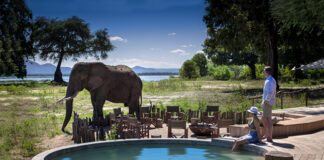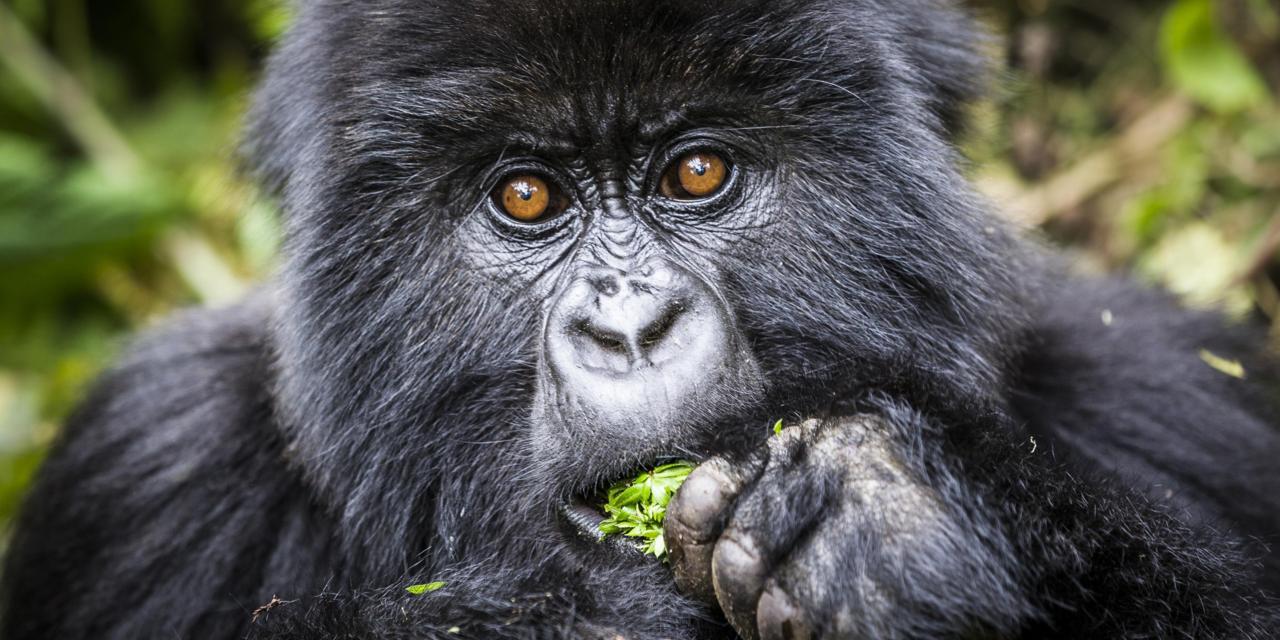The Pendjari National Park
This lies in north western Benin, adjoining the Arli National Park in Burkina Faso. Named for the Pendjari River, the national park is known for its wildlife and is home to some of the last populations of big game like the African forest elephant, West African lion, hippopotamus, buffalo, and various antelopes in West Africa. The park is also famous for its richness in birds.
The rocky cliffs of the area are sparsely wooded with Burkea africana, Detarium microcarpum, Lannea acida, Sterculia setigera and Combretum ghasalense.
On the deep soils of some of the summits and the Atakora escarpment one finds a greater variety of plant species with Isoberlinia doka and Afzelia africana. The Pendjari River has an impressive gallery forest.
The park includes both Sudan and Northern Guinea savannahs, with areas of grassland dominated by Acacia sieberiana and Mitragyna inermis or Terminalia macroptera.
There is a high annual rainfall of around 1,100 millimetres (43 inches); The Park is open year-round, although from June–November rainfall can be heavy and certain parts of the park may be inaccessible.
Pendjari National Park is home to most of the typical game species of the western African savannahs. One of the rarest large mammals, which is still found in Pendjari, is the Northwest African cheetah.
The lion population of Pendjari and adjacent W National Park consists of about 100 animals and is possibly the largest in all of western or central Africa.
As a special feature, almost all male lions of the Pendjari area carry no manes or at best very weak manes.
Originally, the endangered West African wild dog (Lycaon pictus manguensis) was found in Pendjari National Park;[5] and in the adjacent Arli National Park in Burkina Faso,[6] is considered as possibly locally extirpated.
It has been considered extirpated, but a few animals were confirmed during a study in April 2000. Other larger carnivore species include African leopard, spotted hyena, side-striped jackal, and African civet.
Pendjari also has a relatively large population of elephants. Their number was stable over the last decades and counts more than 800 individuals. The second largest animal of the park is the hippopotamus.
There are also good populations of several other large herbivores like Sudanese buffaloes (Syncerus caffer brachyceros; c. 2,700 animals in 2000), western hartebeests (Alcelaphus buselaphus major; c. 1,500 in 2000), roan antelope (c. 2,000 in 2000), kob antelope (c. 2,600 in 2000), and warthogs.
Some other antelope species like korrigum (Damaliscus lunatus korrigum), bushbuck, and reedbuck are relatively rare. Smaller bovids are the red-flanked duiker, oribi, and common duiker.
Primates are represented by olive baboon, patas monkey, and tantalus monkey. The number of waterbucks (Kobus ellipsiprymnus defassa) decreased from about 3000 in the 1970s to only 120 in 2004. The park is renowned for its abundance of birds, with some 300 different species in total.
The Royal Palaces of Abomey
These are 12 palaces spread over an area of 40 hectares at the heart of the Abomey town in Benin, formerly the capital of the West African Kingdom of Dahomey.
The Kingdom was founded in 1625 by the Fon people who developed it into a powerful military and commercial empire, which dominated trade with European slave traders on the Slave Coast until the late 19th century, to whom they sold their prisoners of war.
At its peak the palaces could accommodate for up to 8000 people. The King’s palace included a two-story building known as the “cowrie house” or akuehue.
From 1625 to 1900, 12 kings succeeded one another at the head of the powerful Kingdom of Abomey.
With the exception of King Akaba, who had his own separate enclosure, they all had their palaces built within the same cob-wall area, in keeping with previous palaces as regards the use of space and materials. The royal palaces of Abomey are a unique reminder of this vanished kingdom.
The W National Park or W Regional Park
This is a major national park in West Africa around a meander in the River Niger shaped like the letter W. The park includes areas of the three countries Niger, Benin and Burkina Faso, and is governed by the three governments.
Until 2008, the implementation of a regional management was supported by the EU-funded project ECOPAS. The three national parks operate under the name W Transborder Park.
In the national park, a total of 454 species of plants were recorded, including two orchids found only in Niger. The park is known for its large mammals, including aardvark, baboon, African buffalo, caracal, cheetah, African bush elephant, hippopotamus, African leopard, West African lion, serval and warthog.
The park provides a home for some of West Africa’s last wild African elephant. However, the rare West African giraffe, today restricted to small parts of the Niger, is absent from the park.
The W Park is also known for historic occurrence of packs of the endangered West African wild dog, although this canid may now be extirpated from the area.
The National Park is one of the last strongholds for the Northwest African cheetah. A small population of 25 individuals is estimated to be resident across the W–Arli–Pendjari protected area complex.
The W National Park is also known for its bird populations, especially transitory migrating species, with over 350 species identified in the park. The park has been identified by Birdlife International as an Important Bird Area.
The Cotonou Central Mosque
This is a mosque in Cotonou, Benin. It is the most important building for the country’s Muslims. The Cotonou Central Mosque is a major Islamic center of worship in the capital, the mosque has a great importance for the Islamic community in Benin, and it is built on the ancient architectural design which makes it stand out as a famous and a unique religious site in Cotonou. It is worth paying a visit if you are in the city.
The Basilique de l’Immaculée Conception
This is a Roman Catholic minor basilica dedicated to the Immaculate Conception located in Ouidah, Benin. The basilica is under the circumscription of the Archdiocese of Cotonou. The basilica was dedicated on November 9, 1989.
The exterior is dominated by a 70 metres (230 ft) spire, and two lesser spires (not completed until 1908). Above the entrance is a mosaic depicting Pope Pius IX, who defined the dogma of the Immaculate Conception in 1854.
The clock plays the Ave Maria hourly, and chimes the hours with a 2-tonne bell called Jeanne-Alphonsine. The other bells in the tower are named Geneviève-Félicie (weighing 1800 kg), Hermine-Benoîte (1100 kg), and Cécile-Gastine (800 kg).
The walls are lined with ex voto plaques, and banners from official National Pilgrimages of the past. It has a series of stained glass windows depicting various events in the story of Lourdes, and the clerestory windows depict Mary as the Second Eve.
The Royal Palace, Porto
This is also known as King Toffa’s Palace and more recently Musée Honmé, is a former royal residence and today museum in Porto-Novo, Benin. It contains an example of an Alounloun and most displays are related to the King Toffa period.
The palace and the surrounding district were added to the UNESCO World Heritage Tentative List on October 31, 1996 in the Cultural category.
Stade de l’Amitie or Friendship Stadium
This is a multi-purpose stadium in Cotonou, Benin. It is currently used for football matches and also has facilities for athletics. The stadium has a capacity of 20,000 people.
The Ancien Pont
This is a bridge in Cotonou, Benin. The bridge crosses the Lagune de Cotonou which separates the two sides of the city. It was built in 1928 and renovated in 1981.
The Alexandre Sènou Adandé Ethnographic Museum
This is a museum in Porto-Novo, Benin. It was established in 1957 by the Dahomey Institute. It is operated by Alexandre Sènou Adandé, a noted ethnologist, who was chief archivist and librarian at the Institut Fondamental d’Afrique Noire of Dakar from 1948 to 1960.
Musée en Plein Air de Parakou
This is a museum located approximately 1.5 kilometres south of the centre of the city Parakou, Benin in the suburbs. The museum consists of five circular complexes representing the traditional housing of the local Batanou peoples.
The museum as of 2006 was in difficulty given that it lacks the funds and maintenance to allow it to fulfil its potential as a showcase. The museum charges a CFA franc 1500 entrance fee.
The Ouidah Museum of History is an historical museum in Ouidah, Benin.








